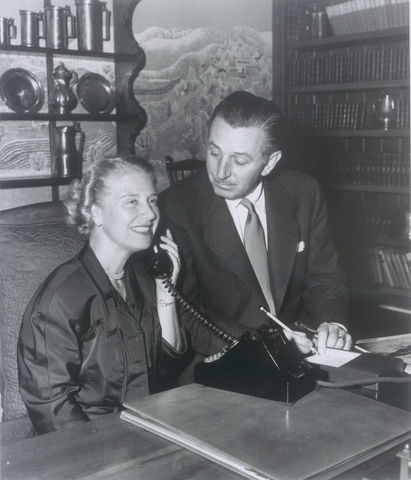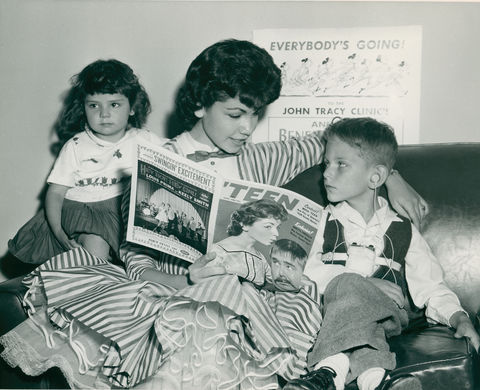Throughout his life, Walt Disney was dedicated to giving back to his community and generously supported many charities, especially those that benefitted children. From Toys for Tots to the Jules Stein Eye Institute at UCLA, Walt’s charitable giving often extended beyond monetary support. The John Tracy Clinic—now known as the John Tracy Center—was an organization close to Walt’s heart and, from its inception, he was an active supporter of its efforts.

The John Tracy Clinic was founded by Louise Treadwell Tracy and her husband, notable actor Spencer Tracy, in honor of their son John whose significant hearing loss was discovered at the age of 10 months. Louise Tracy dedicated herself to learning how hearing-impaired children could be taught to communicate, and her work with her son was a resounding success. In turn, she wanted to help provide families in similar situations with much-needed support and resources, founding the John Tracy Clinic in which became the “first organization on the West Coast to develop a parent-centered, spoken-language curriculum for preschoolers with hearing loss.” To help with her effort, Louise turned to her closest circle of friends who were influential in Hollywood, one of whom was Walt Disney.
Fellow avid polo players, Spencer and Louise Tracy first met Walt Disney on the polo field, and they would often invite Lillian and Walt over for dinner. In 1938, Walt included an animated caricature of Spencer in Mother Goose Goes Hollywood, featuring some of Hollywood’s biggest stars of the time. Recalling her experience meeting Walt on the polo field, Louise shared, “He was a beginner, you see, and he just loved it for the fun. So I called him and asked if he would go on the board, maybe be the Vice President. ‘Sure,’ he said.”
Starting in 1943, Walt became the first Chairman of the Board of Directors for the Clinic. At the time, Walt was immersed in film production for the United States’ WWII effort. He was eager to support the new Clinic and wanted to see firsthand how it operated. While touring the Clinic with Louise, they visited children during nap time. Walt asked if the children had cots to sleep on, and Louise expressed that they slept on mats on the floor. According to Louise, “The next day there were cots and, at Christmastime, a truckload of gifts—puppets and toys, all Disney-licensed—that could be used in teaching.”
After serving as Chairman of the Board for the Clinic, Walt served as Vice President of the Board of Directors until his passing in 1966. In 1948, he chaired the Endowment Committee and sponsored the premiere of the short film, Listening Eyes (1948), showcasing the Clinic’s mission. Walt enlisted one of his leading live-action directors, Larry Lansburgh, to direct. Walt helped fund the film and, to help with costs, they enlisted USC School of Cinematic Arts students to help with sets and production.
Production began in 1946. In the film, Louise played herself meeting with a young mother who is learning to care for her young daughter who is deaf. Spencer Tracy narrated the short, lamenting the heartbreaking possibility that the young mother may never hear her daughter say “Mother,” mirroring Spencer’s own comments when he first learned that he was a parent of a child who is deaf. The short showcases the Clinic’s role in the lives of the families with children who are deaf and hearing-impaired, and the education provided by the Clinic to young children to help with communication. Pulling from the Tracy family’s own experience, the young mother in the short “experiences a moment never to be forgotten” when, for the first time, her daughter does indeed say “Mother.”

The film premiered at Grauman’s Egyptian Theatre as part of a benefit fundraiser for the John Tracy Clinic. At the benefit, Louise comically quipped, “[Walt] has been very much interested in our Clinic because he has known John since he was a little fellow and was on our original Board of Directors and yet it took him five years to get around to […] mak[ing] a picture about us.”
The John Tracy Clinic was a continuing commitment for Walt and his studio. For their annual benefit, he would often recruit studio employees and contracted performers to help with fundraising efforts. Mouseketeer Annette Funicello visited the children at the Clinic and would often participate in the annual fundraising bazaars in the 1960s. Mickey Mouse Club (1955–58) star Kevin Corcoran recalled, “We would go over and put on a show there to raise money once a year. And it was something that Walt believed in and he supported them greatly. And they would have, after the show, a luncheon. And you would go in and you would have lunch and I remember looking up after the luncheon, and there was a fellow bussing the tables after the luncheon was over. And it was Walt. He was bussing all of the tables and seeing if anybody needed something else. I mean, we’re talking about 150, 200 people in a room and he’s cleaning up after them.”
Walt's generosity and interest in the education of children around the world was apparent with his support of the John Tracy Clinic. He always willing to help wherever needed, whether it was bussing tables or picking up a trash can. Spencer Tracy never had to Guess Who’s Coming to Dinner? (1967)—if it was a John Tracy Clinic benefit, more often than not, it was Walt Disney.
–Bri Bertolaccini, Marketing Manager
Image sources (in order of appearance):
- Louise Treadwell Tracy and Walt Disney, c. 1953; gift of Ron and Diane Miller, collection of the Walt Disney Family Foundation; © Disney
- Disney Legend Annette Funicello reading Teen magazine to a boy and girl at the John Tracy Clinic, 1959; gift of Ron and Diane Miller, collection of the Walt Disney Family Foundation; © Disney
